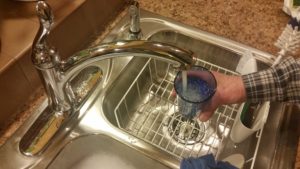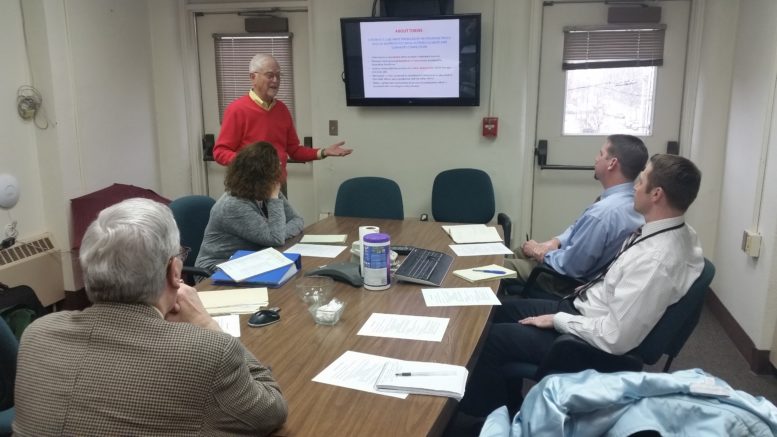By JAN LARSON McLAUGHLIN
BG Independent News
The recent Waterkeeper conference on the health of Lake Erie spread plenty of blame around for the conditions that turn the water green and make it unsafe to consume – much of it directed toward the continued practice of spreading too much manure on farm fields.
But one entity got a gold star from a member of the Lake Erie Waterkeeper board – Bowling Green’s water treatment plant.
It isn’t that the water going into the plant is pristine – quite to the contrary. What’s notable is the treated water that the plant sends out to its water customers.
Dr. Earl Campbell was presenting data on some very technical contaminants, when he happened to mention that in the last two years, Bowling Green’s reservoir water repeatedly had very high levels of the microcystin, from blue-green algae. The difference between how Toledo and Bowling Green handled the contaminant was major.
“It just happened that Bowling Green tested it,” Campbell said. “The person running that plant stood between the people and disaster.”
At that point, no standard orders were in place in Ohio to test for the microcystins.
“A lot of people were paying absolutely no attention to this,” Campbell said. But Bowling Green officials, with their static reservoir water drawn from the Maumee River, tested and treated the water. “It was their own initiative.”
Campbell said there are 146 Concentrated Animal Feeding Operations in the region, which each having either cows numbering 1,000 or more, and pigs numbering 2,500 or more.
“There is more shit than the land to put it on,” he said. “The land can’t hold this all.”
The result is phosphorous rates in the Maumee River and Lake Erie that have been “off of the charts,” Campbell said.

When asked by an audience member about the safety of Bowling Green water, Campbell replied, “I think you’re probably safer there than most places.”
The key has been the city’s investment in its water treatment plant.
“Bowling Green has been very astute,” he said, listing off the reverse osmosis system at the plant as significant. “Bowling Green wisely invested in this fantastic water plant.”
So last week, Campbell met with Bowling Green Mayor Dick Edwards and city utility department officials for two reasons. He wanted to praise them for their water efforts, and he wanted to ask them to join an effort to clean up the water before it reaches their treatment plant.
When phosphorous from fertilizer and manure runs off farm fields, Bowling Green has been doing the right thing. “For a long time, they’ve been paying for other people’s pollution.”
But all communities aren’t that fortunate, and Campbell said he worries about small towns with reservoirs that aren’t doing necessary testing and treatment.
“How many other village or towns have this,” type of system in place, he asked.
So while Campbell praised Bowling Green’s efforts, he also asked officials to request that the Maumee River and Lake Erie be declared “legally impaired.”
According to Campbell, the Ohio Environmental Protection Agency has found several tributaries into the Maumee River to be legally impaired because of bacteria, nitrate, ammonia and other contaminants. That means the waterways are out of conformity with federal guidelines and must be remediated to protect the drinking water and recreational water.
The declaration is needed to get changes enacted, Campbell said. Efforts have also been made to get Toledo to support the declaration, but without success.
“Toledo, which sits on the edge of disaster,” he said, explaining it’s difficult to get entities to take the necessary steps. “There are politics involved.”
“We seem to have difficulty getting people to listen to us,” Campbell said. “This is a failure of political will to make it happen.”
Campbell asked Bowling Green officials to support the following steps:
- Have the Western Basin of Lake Erie declared legally impaired by appealing to Region 5 of the U.S. EPA, Ohio EPA and governor.
- Have a study of microcystis and the effects on humans.
- Hold a conference for mayors and municipal council members along the Maumee River.
Campbell was critical of state officials afraid to label Lake Erie as in distress. “They don’t want Lake Erie to be tagged,” he said. “The state legislature seems to not know anything about science and seems not to be very curious.”
Bowling Green Mayor Dick Edwards said he would support a conference if it focused on the scientific and medical community. It needs to have a “scientific backbone,” not a political tone, he said.
Edwards also noted the efforts of one state legislator, Sen. Randy Gardner, R-Bowling Green, in helping address the issue of the lake’s water quality.
“His stand is admirable and heroic,” Campbell agreed.
Edwards also praised the wisdom of past Bowling Green leaders for investing in water treatment and in setting up an independent board of public utilities that is a bipartisan body. “This has really paid off,” he said.

